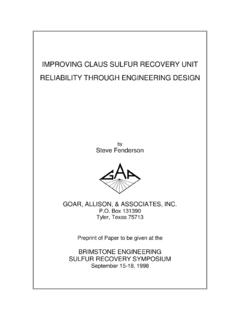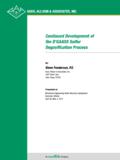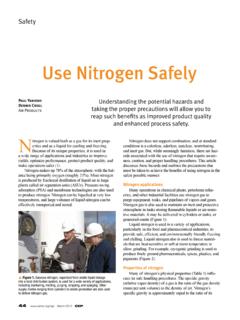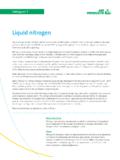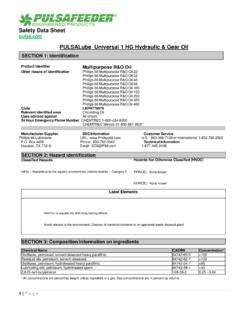Transcription of Oxygen Enrichment Fundamentals
1 Oxygen Enrichment of Sulfur Recovery Units to Boost Capacity, Conserve Capital, and Improve Environmental PerformanceBy:Elmo Nasato Uday ParekhGoar Allison Ltd. air products and Chemicals, Barrister Place 7201 Hamilton BoulevardOakville, Ontario K6M 3C4 Allentown, PA 18195-1501 Canada Phillip MorrisAir Products PLCH ersham Place Technology ParkMolesey RoadHershamWalton-on-ThamesSurrey KT12 4 RZUnited KingdomPresented at:Sour Oil and Gas Advanced Technology ConferenceAbu Dhabi, UAEA pril 2008 Oxygen Enrichment OF SULFUR RECOVERY UNITS TO BOOST CAPACITY, CONSERVE CAPITAL, AND IMPROVE ENVIRONMENTAL PERFORMANCE Elmo Nasato Goar, Allison & Associates, Toronto, Canada Uday Parekh air products and Chemicals, Inc, Allentown, PA, USA Philip Morris air products and Chemicals, Inc, Hersham, UK 1.
2 INTRODUCTION Current trends in the characteristics of crude oil supply, petroleum product demand, and tightening environmental regulations require continuous change in the worldwide refining industry. Refiners are confronted with more stringent specifications on motor transportation fuels, greater demand for light transportation fuels, and increasing dependence on heavy, sour crude oil feedstock. Environmental regulations in Europe, North America, Asia and other regions all require progressively cleaner motor transportation fuels.
3 product demand is continually shifting from heavy bottom of the barrel products toward light transportation fuels. Simultaneously, an overall lighter product mix must be produced from a heavier crude slate. These developments have led to reconfiguring refinery processes with greater use of hydroprocessing to upgrade crude oil into light transportation fuels and to improve fuel quality. More hydrotreating and increased processing severity is required for removing sulfur and nitrogen compounds from fuels to meet future environmental regulations.
4 The resulting increase in production of hydrogen sulfide (H2S) and ammonia (NH3) has placed new demands on the processing capability of refinery sulfur recovery units (SRU s). A good example of the challenge can clearly be seen in the graph depicting how the sources of sulfur production have shifted dramatically (Figure 1). The growth in sulfur from oil refining is particularly noticeable and is expected to continue. This trend is reflective of most other regions in the world and refiners and sour gas processors need to find the most economic way to handle these increases.
5 In many cases, Oxygen Enrichment has proved to be the best solution to boost SRU capacity. Figure 1 Change in Sulfur Production Sources During the 20th Century 0246810121900191019201930194019501960197 0198019902000 Million Metric TonsFraschPyritesNatural GasBy- product Sulfuric AcidSulfur from RefineriesPetroleumSource: USGS024681012190019101920193019401950196 01970198019902000 Million Metric TonsFraschPyritesNatural GasBy- product Sulfuric AcidSulfur from RefineriesPetroleumSource: USGSO xygen Enrichment of the combustion air to the reaction furnace is a proven means of increasing SRU capacity, and of improving the SRU s ability to handle contaminants.
6 Expanding SRU capacity with Oxygen Enrichment is gaining broad acceptance for handling extra acid gas loading at significantly reduced capital expense. Oxygen Enrichment is also finding application as the answer to requirements for SRU redundancy and improved sulfur recovery. The concept of increasing SRU capacity with Oxygen Enrichment has been of interest for at least thirty years, and has been applied on a commercial scale since 1985. The typical SRU reaches its ultimate sulfur production capacity when the maximum allowable front-end pressure prevents further increase in feed rate.
7 Oxygen Enrichment reduces the flow of process gases by reducing the quantity of nitrogen that enters with the combustion air. This reduction in process flow rate allows a corresponding increase in SRU acid gas feed rate and subsequent increase in sulfur production. Commercial application of Oxygen Enrichment with acid gas feeds rich in H2S has been limited by the maximum allowable operating temperature of the SRU reaction furnace refractory. Commercially available refractory have demonstrated reliability at process temperatures of up to about 2800 F (1540 C).
8 Some companies prefer to conservatively limit process operating temperatures to a range as low as 2500-2600 F (1370-1430 C). Of course, the choice of maximum allowable furnace operating temperature has a bearing on the SRU throughput that can be achieved without special temperature moderating techniques. Furthermore, the increase in furnace temperature is to some degree self-moderating, since a higher temperature increases H2S dissociation, which is an endothermic reaction. Dissociation also reduces the amount of H2S remaining for reaction and therefore less combustion is required, ultimately decreasing the heat release and temperature.
9 2. SRU Oxygen Enrichment THEORY The underpinning theoretical concept that makes Oxygen Enrichment such an effective means of debottlenecking Claus sulfur plants is briefly explained in this section. In the Claus process about one-third of the hydrogen sulfide in the acid gas stream is combusted to sulfur dioxide which further reacts with the remaining hydrogen sulfide to form elemental sulfur and water in the vapor phase. The combustion reaction and approximately 60-70% of the conversion of hydrogen sulfide to sulfur, take place in the thermal reactor at temperatures between 1100 and 1400o C for typical refinery acid gas streams.
10 The remaining equilibrium conversion of hydrogen sulfide to sulfur takes place in a series of catalytic reactors at much lower temperatures. Representative reactions are summarized below: H2S + 3/2 O2 SO2 + H2O (Combustion reaction) 2H2S + SO2 3S + 2H2O (Claus reaction) 3H2S + 3/2 O2 3S + 3H2O (Overall reaction) Stoichiometrically, 100 kmol/h of hydrogen sulfide requires 50 kmol/h of Oxygen . If all of the Oxygen is provided by the air, 189 kmol/h of nitrogen comes along with the 50 kmol/h of Oxygen .
